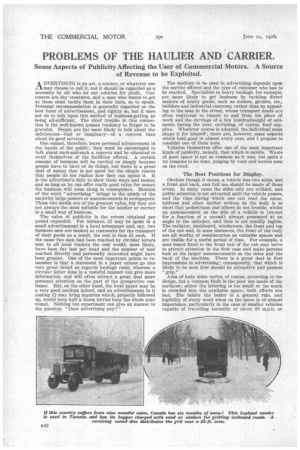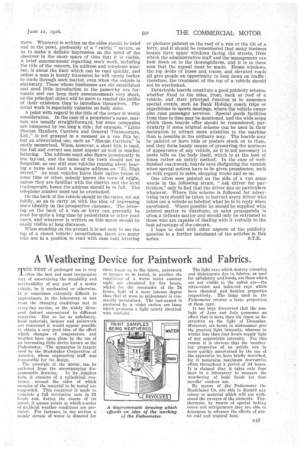PROBLEMS OF THE HAULIER AND CARRIER.
Page 26

Page 27

If you've noticed an error in this article please click here to report it so we can fix it.
Some Aspects of Publicity Affecting the User of Commercial Motors. A Source of Revenue to be Exploited.
ADVERTISING is an art, a science, or whatever one may choose to call it, but it should be regarded as a necessity by all who let out vehicles for profit. Cudtamers are shy creatures, and a man who wants to get at them must tackle them in their lairs, so to speak. Personal recommendation is generally regarded as the best form of advertisement, and rightly so, but it does not do to rely upon this method a business-getting as being all-sufficient. The chief trouble in this connection is the well-known human tendency to forget to be grateful. People are far more likely to talk about the deficiencies—real or imaginary—of a concern than about its good services.
One cannot, therefore, leave personal advancement in the hands of the public; they must be encouraged to talk about such-and-such a concern and be educated to avail themselves of the facilities offered. A certain amount of business will be carried on simply because people have to have or do things, but there is a great deal of money that is not spent for the simple reason that people do not realize how they can spend it. It is the advertiser's duty to show them ways and means, and so long as he can offer really good value for money the business will come along in consequence. Mention of the word " advertising " brings to the minds of the majority large posters or announcements in newspapers. These two media are of the greatest value, but they are not always the most suitable for the haulier or carrier in a small way of business.
The value Of publicity is the return obtained per pound expended. For instance, £2 may be spent in a small advertisement in a local newspaper and, say, two business men are booked as customers for the transport of their goods as a result, the cost is then 11 each. If the same two men had been reached by circular letters sent to all local traders the cost would, most likely, have been far less per head and the number of men reached directly and personally interested might have been greater. One of the most important points to remember is that a statement in a paper cannot go into very great detail as regards haulage costs, whereas a circular letter done in a tasteful manner can give more information, and will often attract a great deal more personal attention on the part of the prospective customer. But, on the other hand, the local paper may be a very good medium indeed, and an advertisement in it costing £2 may bring inquiries which, properly followed up, would keep half a dozen lorries busy the whole year round. Nothing but experiment can give an answer to the question, "Does advertising pay?"
The medium to be used in advertising depends upon the service offered and the type of customer who has to be reached. Specialists in heavy haulage, for example, are more likely to get business by tackling direct makers of heavy goods, such as boilers, girders, etc., builders and industrial concerns, rather than by appealing to the man in the street, whose transport needs ate often restricted •to transit to and from his place of work and the carriage of a few hundredweight of oddments during the year, excluding, of course, food supplies. Whatever course is adopted, the individual must shape it for himself ; there are, however, some aspects which hold good in almost every case, and I propose to consider one of them here.
Vehicles themselves offer one of the most important kinds of publicity, namely, that which is mobile. Waste of good space is not so common as it was, but quite a lot remains to be done, judging by vans and lorries seen on the road.
The Best Positions for Display.
Obvious though it seems, a vehicle has two sides, and a front and back, and full use should be made of these areas. In many cases the sides only are utilized, and public attention is not att./acted until the vehicle passes, and the time during which one can read the name, address and other matter written on the body is so short that pedestrians and others do not trouble, whilst an announcement on the side of a vehicle is (except for a fraction of a second) always presented at an angle to the onlooker, and thus is not readily legible. The radiator, dashboard, windscreen, the front and top of the cab and, in some instances, the front of the body are all worthy of consideration as valuable spaces and are visible for a useful period of time. For example, a neat board fixed to the front rail of the cab may serve to attract attention in the first case and make persons look at the larger announcements on the sides and the back of the machine. There is a great deal in first impressions in adv&tising ; consequently, that which is
likely to be seen first should be attractive and possess grip..
Area of body sides varies, of course, according to the design, but a common fault is the poor use made of the surfaces; either the lettering is too small or too much is crowded into the available space; both effects are bad. The bolder the better is a general rule, and legibility of every word when on the move is of utmost importance, particularly in the case of smaller vehicles capable of travelling normally at about 20 m.p.h. or
more. Whatever is written on the sides should be brief and to the point, preferably of a " catchy " nature, so as to make a definite impression on the mind of the observer in the short space of time that it is visible. A brief announcement regarding one's work, including the title of the concern, its address and telephone number, is about the limit which can be read quickly, and unless a man is keenly interested he will rarely bother to wade through such matter, even when the vehicle is stationary. Those whose businesses are old established and need little introduction to the passer-by are fortunate and can keep their announcements very short, as the principal object will be more to remind the public of their existence than to introduce themselves. Pictorial work is especially valuable on body sides.
A point with regard to the title of the owner is worth consideration. In the case of a proprietor's name, matters are usually straightforward, but some companies are hampered by too long a title ; for example, Little Slocum Hauliers, Carriers and General Transporters, Ltd.," is not grasped in a moment as a van flits by, but an abbreviated one, such as " Slocum Carriers," is easily memorized. When, however, a short title is used, the full and correct one must appear as well in smaller lettering. The address must also figure prominently in the lay-out, and the name of the town should not be forgotten, as one still sees vehicles running about bearing a name and such a meagre address as "35, High Street." As most vehicles leave their native towns at some time or other, nobody knows the town of origin, unless they are familiar with the district and the local tradespeople, hence the address should be in full. The telephone number must not be overlooked.
On the back of the vehicle should be the name, set out boldly, so as to carry on with the idea of impressing one's identity on the prospective customer. The lettering on the back of a van or lorry can generally be read for quite a long time by pedestrians or other road users, and whatever is written on this space should be easily visible at long distances.
When standing on the ground it is not easy to see tile top of a closed vehicle ; nevertheless, there are many who are in a position to read with ease bold lettering or pictures painted on the roof of a van or the tilt of a lorry, and it should be remembered that many business houses have upper windows facing the streets, from which the administrative staff and the management can look down on to the thoroughfares, and it is to these men that the appeal must be made. House windows, the top decks of buses and trams, and elevated roads all give people an opportunity to look down on traffic ; therefore, the treatment of the top of a vehicle should not be overlooked.
Detachable boards constitute a good publicity scheme, whether fixed to -the sides, front, back or roof of a vehicle, and their principal function is to announce special events, such as Bank Holiday coach trips or expeditions to sports meetings, where the vehicle owner also runs passenger services. Special goods facilities from time to time may be mentioned, and the wide scope which these boards offer should be remembered, particularly if some original scheme can be used in their decoration to attract more attention to the machine than is possible in the ordinary way. The boards may be painted or have bills or posters stuck on to them, and they form handy means of preserving the neatness of appearance of any vehicle, as it is not necessary to paste bills on the body itself, which is at the best of times rather an untidy method. In the case of wellfinished coachwork, boards save disfiguring the varnish when special notices have to Be given prominence, such as with regard to sales, shopping weeks and so on.
One often sees painted -on the side of a van some words in the following strain, "Ask driver for particulars," only to find that the driver has no particulars whatever. Where this scheme is followed for advertising care should be taken to instruct every driver who takes out a vehicle so labelled what he is to reply when questioned. Where possible he should be supplied with printed matter to distribute, as sales propaganda is often a delicate matter and should only be entrusted to those who are capable of dealing with it verbally to the best advantage of the concern. I hope to deal with other aspects of the publicity question in a further instalment of the articles in this
series. S.T.R.






























